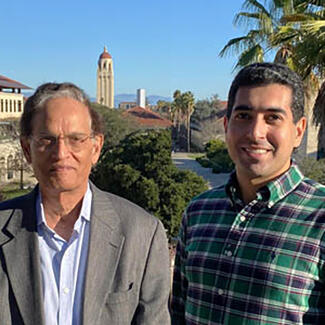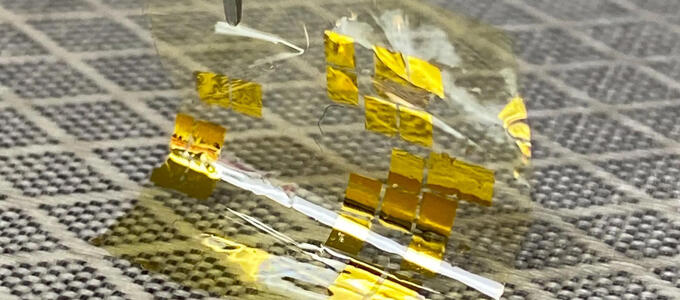
Krishna Saraswat and team find efficiencies in a promising group of photovoltaic materials
New solar materials – transition metal dichalcogenides – or TMDs – could usher in ultrathin, lightweight solar panel.
Co-lead authors Koosha Nassiri Nazif and Alwin Daus, both EE postdoctoral scholars, describe their tungsten diselenide solar cells that boast a power-per-weight ratio on par with established thin-film solar cell technologies in their recently published paper. Their prototype achieves 5.1 percent power conversion efficiency, and the team projects they could practically reach 27 percent efficiency upon optical and electrical optimizations. That figure would be on par with the best solar panels on the market today, silicon included.
Their prototype realized a 100-times greater power-to-weight ratio of any transition metal dichalcogenides (TMDs) yet developed. That ratio is important for mobile applications, like drones, electric vehicles and the ability to charge expeditionary equipment on the move. When looking at the specific power – a measure of electrical power output per unit weight of the solar cell – the prototype produced 4.4 watts per gram, a figure competitive with other current-day thin-film solar cells, including other experimental prototypes.
"Imagine an autonomous drone that powers itself with a solar array atop its wing that is 15 times thinner than a piece of paper," said Koosha Nassiri Nazif, a doctoral scholar in EE. "That is the promise of TMDs."
"We think we can increase this crucial ratio another ten times through optimization," adds Krishna, they estimate the practical limit of their TMD cells to be a remarkable 46 watts per gram.

WSe2 solar cells on a flexible polyimide substrate
This is collaborative work between the research groups of Professor Krishna Saraswat and Professor Eric Pop.
Additional authors include
- Department of Electrical Engineering: Koosha Nassiri Nazif, Alwin Daus, Sam Vaziri, Aravindh Kumar, Frederick Nitta, Siavash Kananian, Raisul Islam, Prof. Ada S. Y. Poon, Prof. Eric Pop & Prof. Krishna C. Saraswat
- Geballe Laboratory for Advanced Materials (GLAM): Jiho Hong, Nayeun Lee & Prof. Mark L. Brongersma
- Department of Materials Science and Engineering: Jiho Hong, Nayeun Lee, Michelle E. Chen, Prof. Mark L. Brongersma, Prof. Eric Pop & Prof. Krishna C. Saraswat
- Department of Electrical and Computer Engineering, Sungkyunkwan University: Kwan-Ho Kim & Jin-Hong Park
- Department of Electrical and Systems Engineering, University of Pennsylvania: Kwan-Ho Kim
- SKKU Advanced Institute of Nanotechnology (SAINT), Sungkyunkwan University: Jin-Hong Park
- Department of Applied Physics: Prof. Mark L. Brongersma
Related Sources
- IEEE Spectrum, "Record Power Boost for New Flexible Solar Tech Prototype bendable cells now match power/weight ratio of best commercial thin-film devices"
- SciTechDaily.com, "New Photovoltaic Materials Developed by Stanford Scientists for Ultrathin, Lightweight Solar Panels"
- Stanford News, "New solar materials developed by Stanford scientists could usher in ultrathin, lightweight solar panel"